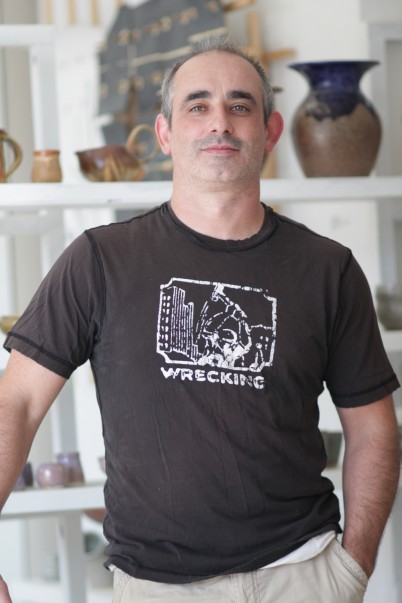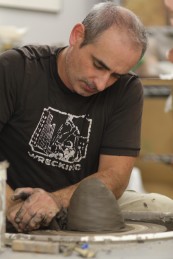“Some people would say I’m a potter. I consider myself a sculptor who happens to work with clay.” That’s how Fiorenzo Berardozzi clears up his role at Cone 10 Studios, a loose co-op of twenty-seven artists and four owners, including Berardozzi.

Before he was a sculptor, Berardozzi was simply a kid helping out his father, a bricklayer and stonemason. His parents immigrated to a South Dakota Indian reservation from Italy not long after Berardozzi was born so help was needed as the family found its feet in America. From age eight to twenty-two he worked with his father and uncle every summer learning about structure, materials and hard work. At eighteen he went to school for mechanical engineering but found his studies restraining. It was on breaks where he would travel to see his sister at a liberal arts college that he discovered he wanted to be artist. After talking to the dean, he began taking some classes in pottery and sculpture. The trouble was back then you were either a sculptor or you were a ceramicist. Trapped between the two, Berardozzi kept pushing his professors, “Why can’t clay be a fine art material?” Consequently he spent his days sneaking back and forth between the sculpture studio and the ceramic studio.
bricklayer and stonemason. His parents immigrated to a South Dakota Indian reservation from Italy not long after Berardozzi was born so help was needed as the family found its feet in America. From age eight to twenty-two he worked with his father and uncle every summer learning about structure, materials and hard work. At eighteen he went to school for mechanical engineering but found his studies restraining. It was on breaks where he would travel to see his sister at a liberal arts college that he discovered he wanted to be artist. After talking to the dean, he began taking some classes in pottery and sculpture. The trouble was back then you were either a sculptor or you were a ceramicist. Trapped between the two, Berardozzi kept pushing his professors, “Why can’t clay be a fine art material?” Consequently he spent his days sneaking back and forth between the sculpture studio and the ceramic studio.

Nowadays the line between potter and sculptor is blurred. The movement began during the Vietnam era as new artists began to use clay like sculpture material, a practice that was unheard of at the time. When teaching pottery began in the nineteen-thirties, universities had always taught students how to make truly refined pots, cups and vessels. To the displeasure of such institutions, artists like Voulkos and Reitz were experimenting by throwing enormous platters on the discs and gouging them out like the abstract expressionists of the ceramic field. Universities disapproved but curious galleries and museums helped launch the new discipline.

Berardozzi shows a piece, pointing out the clay armature that sits inside it. In most sculptures the armature resides in the work only during the building process, but for Berardozzi the armature is part of the sculpture. They’re almost anatomy studies or more precisely like écorché, the process in which the artist draws the bone, then the ligaments and muscles and then finally the skin. However, Berardozzi’s process allows him to do something a painter cannot. When he’s completed the piece, he’ll turn it over to reveal the insides.
 “I’ve always enjoyed figures and machines,” he says as he shows me various pieces in stages of completion. “These are ready to be bisqued (fired without a glaze). It’ll be interesting to see what happens when there done.” Unlike most artists, Berardozzi won’t know what his works will look like until they are complete. The same way that those veterans would gash away at their work, the stress from the fire cracks and reshapes the piece randomly. Free radicals will cause the clay to pull apart and distort without pattern. Berardozzi not only acknowledges this lack of control but embraces it.
“I’ve always enjoyed figures and machines,” he says as he shows me various pieces in stages of completion. “These are ready to be bisqued (fired without a glaze). It’ll be interesting to see what happens when there done.” Unlike most artists, Berardozzi won’t know what his works will look like until they are complete. The same way that those veterans would gash away at their work, the stress from the fire cracks and reshapes the piece randomly. Free radicals will cause the clay to pull apart and distort without pattern. Berardozzi not only acknowledges this lack of control but embraces it.
He shows another piece he’s been working on. Unlike the others which are flipped to reveal the interior, this piece has had a large section of “skin” cut away and removed. “It’s almost like a grid system in there. You lay a piece over the top and it takes the shape. You don’t know exactly what’s underneath but you just start cutting blindly.” Rarely does one see an artist so unconcerned with being in complete control and unattached to perfection.
This attitude might all stem from his training. Berardozzi came from a group of brutal professors who would break his pieces in order to break down the idea that one thing could be sacred, because when you think this one thing is sacred and perfect then how do you make another one? How do you proceed as an artist? Therefore cutting blindly into a piece is okay because it is just clay, it can be remolded, more can be bought, time will be had and perfection is impossible anyway. Achieving something unique and interesting is possible though, but only through experimentation.
 There’s a science to pottery. One has to be a geologist, a chemist and an artist all at once. A potter must be willing to put in the brutal hours of calculation and willing to accept the randomness that may proceed.
There’s a science to pottery. One has to be a geologist, a chemist and an artist all at once. A potter must be willing to put in the brutal hours of calculation and willing to accept the randomness that may proceed.
It might be said that Fiorenzo Berardozzi himself possesses a clay-like structure. First is a nearly measurable balance of dedication and humility in equilibrium like gypsum and feldspar. Next is the unknown constant, the free radical that makes an artist into an individual.











